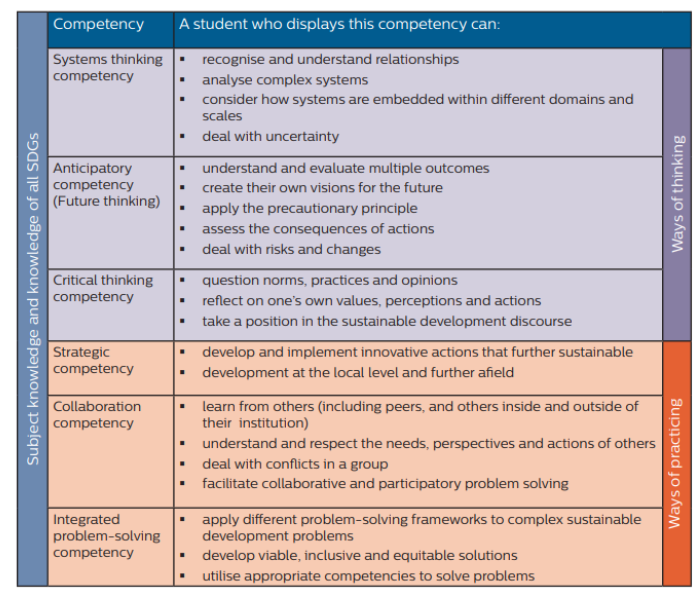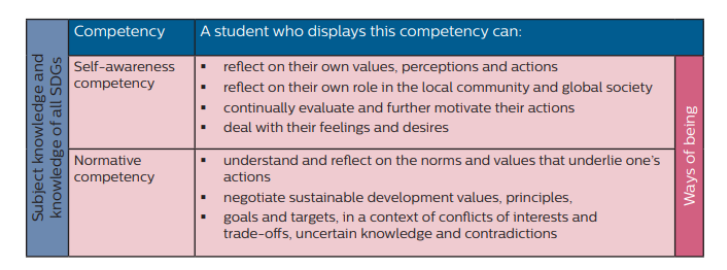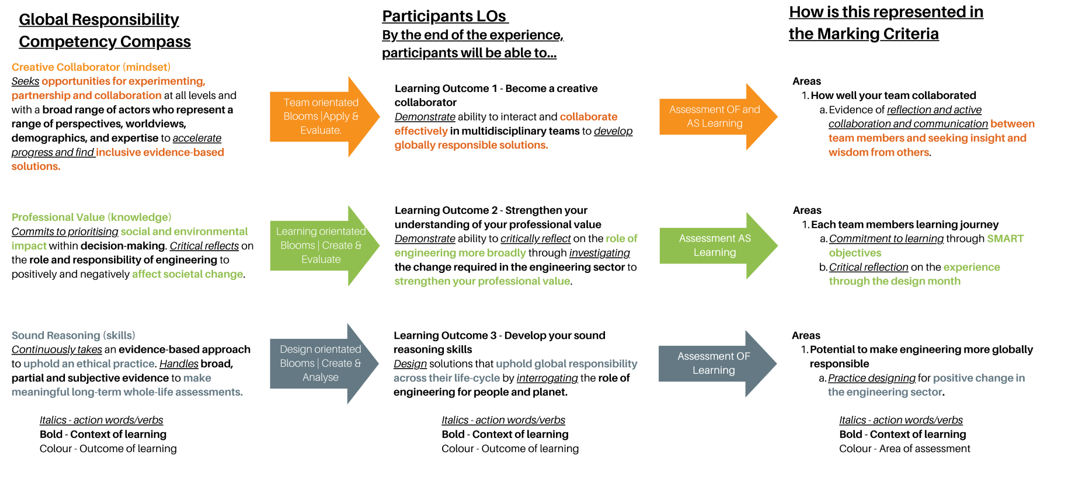Authors: Dr Jonathan Truslove MEng PhD and Emma Crichton CEng MICE (Engineers Without Borders UK).
Topic: Assessing sustainability competencies in engineering education.
Type: Knowledge.
Relevant disciplines: Any.
Keywords: Assessment; Design challenges; Global responsibility; Learning outcomes; Sustainability; AHEP; Higher education; Pedagogy.
AHEP mapping: This resource addresses two of the themes from the UK’s Accreditation of Higher Education Programmes fourth edition (AHEP4): The Engineer and Society (acknowledging that engineering activity can have a significant societal impact) and Engineering Practice (the practical application of engineering concepts, tools and professional skills). To map this resource to AHEP outcomes specific to a programme under these themes, access AHEP 4 here and navigate to pages 30-31 and 35-37.
Related SDGs: SDG 4 (Quality education); SDG 13 (Climate action).
Who is this article for? This article should be read by educators at all levels of higher education looking to embed and integrate sustainability into curriculum design. It may also be of interest for students practising lifelong learning to articulate and explore how their learning translates into competency development as they embark on their careers.
Premise:
Today we know that how we engineer is changing – and this change is happening at a quicker pace than in previous decades. The decisions engineers make throughout their careers shape the world we all inhabit. Consequently, the education of engineers has a profound impact on society. Ensuring our degrees are up to date is of pressing importance to prepare all future practitioners and professionals. Arguably, it is especially important for engineers to act sustainably, ethically and equitably.
How do engineers understand their roles when sustainability becomes a key driver in the context of their work? What does sustainability look like in learning journeys, and how can it be incorporated into assessments? This article does not advocate for simply adding ‘sustainability’ to degrees; rather, it encourages the connection between sustainability competencies and engineering assessments.
Developing 21st-century engineers
Choosing to become an engineer is a great way to be useful to society. Studying an engineering degree can develop what people can do (skills), what they know (knowledge) and how they think (mindset), as well as open up a diverse range of career opportunities.
The path to becoming an engineer can start at university (though there are other routes in). Weaving in a focus on globally responsible engineering throughout a degree course is about embracing the need to develop a broader set of competencies in engineers and expand the types of projects they practise on during their degree to reflect the problems they may encounter during their career.
This doesn’t mean that engineering degrees as they are aren’t valuable or useful. It’s about strengthening the building blocks of degrees to ensure that 21st-century engineers have space to play their role in addressing 21st-century societal challenges. These building blocks are what learning outcomes are prioritised, what pedagogies are used, the types of projects students work on, who they work with and the way we assess learning. All of these elements can be aggregated to develop competence in sustainable engineering practice.
What are sustainability competency frameworks saying?
There are many frameworks exploring what are the competencies most needed today (such as UNESCO Education for Sustainable Development competencies, EU GreenComp, Inner Development Goals). Many frameworks are calling for similar things that allow us to shift focus, attention and energy onto how to truly develop a person over the three to five plus years of experience they might gain at university.
By designing education to meet learning outcomes, you build and evidence a range of competencies, including developing the mindsets of learners. Practically, it is the use of different competency frameworks, and the associated updates to learning outcomes, and how we deliver education and assessment that really matters. The table below, in the second column, synthesises various competency frameworks to clearly articulate what it means a learner can then do. Rather than argue different frameworks, focusing on what a student can do as a result is really key.
Figure 1. Competencies for sustainable development in Advance HE and QAA (2021) and UNESCO Education for Sustainable Development (2017).
By reading through this table, you can see that this is more than just about ‘sustainability’ – these are useful things for a person to be able to do. Ask yourself, what if we don’t develop these in our graduates? Will they be better or worse off?
Graduates can then build on this learning they have had at university to continue to develop as engineers working in practice. The Global Responsibility Competency Compass for example points practitioners to the capabilities needed to stay relevant and provides practical ways to develop themselves. It is made up of 12 competencies and is organised around the four guiding principles of global responsibility – Responsible, Purposeful, Inclusive and Regenerative.
What needs to shift in engineering education?
The shifts required to the building blocks of an engineering degree are:
- To adapt and repurpose learning outcomes.
- To integrate more real-world complexity within project briefs.
- To be excellent at active pedagogies and mindset development.
- To ensure authentic assessment.
- To maximise cross-disciplinary experience and expertise.
All of the above need to be designed with mechanisms that work at scale. Let’s spotlight two of these shifts, ‘to adapt and repurpose learning outcomes’ and ‘to integrate authentic assessment’ so we can see how sustainability competence relates.
Adapt and repurpose learning outcomes.
We can build on what is already working well within a degree to bring about positive changes. Many degrees exhibit strengths in their learning outcomes such as, developing the ability to understand a concept or a problem and apply that understanding through a disciplinary lens focused on simple/complicated problems. However, it is crucial to maintain a balance between addressing straightforward problems and tackling more complex ones that encourage learners to be curious and inquisitive.
For example, a simple problem (where the problem and solution are known) may involve ‘calculating the output of a solar panel in a community’. A complex problem (where the problem and solution are unknown) may involve ‘how to improve a community’s livelihood and environmental systems, which may involve exploring the interconnectedness, challenges and opportunities that may exist in the system.
Enhancing the learning experience by allowing students to investigate and examine a context for ideas to emerge is more reflective of real-world practice. Success is not solely measured by learners accurately completing a set of problem sets; rather, it lies in their ability to apply concepts in a way that creates a better, more sustainable system.
See how this rebalancing is represented in the visual below:
Figure 2. Rebalancing learning within degrees to be relevant to the future we face. Source: Engineers Without Borders UK.
Keeping up to date and meeting accreditation standards is another important consideration. Relating the intended learning outcomes to the latest language associated with accreditation requirements, such as AHEP4 (UK), ABET (US) or ECSA (SA), doesn’t mean you have to just add more in. You can adapt what you’ve already got for a new purpose and context. For instance, the Engineering for One Planet framework’s 93 (46 Core and 46 Advanced) sustainability-focused learning outcomes that hundreds of academics, engineering professionals, and other key stakeholders have identified as necessary for preparing all graduating engineers — regardless of subdiscipline — with the skills, knowledge, and understanding to protect and improve our planet and our lives. These outcomes have also been mapped to AHEP4.
Integrate authentic assessment:
It is important that intended learning outcomes and assessment methods are aligned so that they reinforce each other and lead to the desired competency development. An important distinction exists between assessment of learning and assessment as or for learning:
- Assessment OF learning e.g. traditional methods of assessment of student learning against learning outcomes and standards that typically measure students’ knowledge-based learning.
- Assessment AS/FOR learning e.g. reflective and performance-based (e.g. self-assessments, peer assessments and feedback from educators using reflective journals or portfolios) where the learning journey is part of the assessment process that captures learners’ insights and critical thinking, and empowers learners to identify possibilities for improvement.
Assessment should incorporate a mix of methods when evaluating aspects like sustainability, to bring in authenticity which strengthens the integrity of the assessment process and mirrors how engineers work in practice. For example, University College London and Kings College London both recognise that critical evaluation, interpretation, analysis, and judgement are all key skills which will become more and more important, and making assessment rubrics more accessible for students and educators. Authentic assessment can mirror professional practices, such as having learners assessed within design reviews, or asking students to develop a portfolio across modules.
Engineers Without Borders UK | Assessing competencies through design challenges:
Below is an example of what Engineers Without Borders UK has done to translate competencies into assessment through our educational offerings. The Engineering for People Design Challenge (embedded in-curriculum focuses on placing the community context at the heart of working through real-world project-based learning experiences) and Reshaping Engineering (a co-curricular voluntary design month to explore how to make the engineering sector more globally responsible). The competencies in the Global Responsibility Competency Compass are aligned and evidenced through the learning outcomes and assessment process in both challenges.
Please note – the Global Responsibility Competency Compass points practitioners to the capabilities needed to stay relevant and provides practical ways to develop themselves.
- For educators looking to keep curriculum and learning outcomes relevant, the Compass provides a useful framing to inform learning outcomes throughout the curriculum that encourages lifelong learning for emerging engineers or supports the reskilling of engineering professionals (to pursue topics that may have been absent from the user’s formal education), and constantly evolving their competency through educational activities.
- For students, this may be of interest as you begin your journey as future engineering professionals and student members of professional engineering institutions exploring what continued professional development you wish to pursue in your careers.
See below an example of the logic behind translating competencies acquired by participants to assessment during the design challenges.
Figure 3. Example of the logic behind translating the Global Responsibility Competency Compass to assessment during the design challenges. Source: Engineers Without Borders UK.
-
- The Competencies developed through the educational offering are orientated around the Global Responsibility Competency Compass to align with the learning journey from undergraduate to practising globally responsible individuals in learners’ future careers.
- We then align learning outcomes to the competency and purpose of the design challenge using simple and concise language.
a. Useful resources that were used to help frame, align and iterate the learning outcomes and marking criteria are shared at the end of this article.
-
- The Marking Criteria draws on the assessment methods previously mentioned under ‘Assessment OF’ and ‘Assessment AS/FOR’ while aligning to the context of intended learning i.e. design focussed, individual journals reflecting on the learning journey, and collaborating in teams.
- We frame and align key action words from Competency to learning outcome to marking criteria using Bloom’s taxonomy (in Figure 2) to scale appropriately, the context of learning and what the intended outcome of learning/area of assessment would be.
Conclusions:
How your students think matters. How they engage in critical conversations matters. What they value matters. How we educate engineers matters.
These may feel like daunting shifts to make but developing people to navigate our future is important for them, and us. Sustainability competencies are actually about competencies that are useful – the label ‘sustainability’ may or may not help but it’s the underlying concepts that matters most. The interventions that we make to instil these competencies in the learning journeys of future engineers are required – so degrees can be continuously improved and will be valuable over the long term. Making assessment mirror real practice helps with life-long learning. That’s useful in general, not just about sustainability. This is a major opportunity to attract more people into engineering, keep them and enable them to be part of addressing urgent 21st century challenges.
“Sustainability is more than a word or concept, it is actually a culture, and if we aim to see it mirrored in the near future, what better way exists than that of planting it in the young hearts of today knowing they are the leaders of the tomorrow we are not guaranteed of? It is possible.”
2021 South African university student (after participating in the Engineering for People Design Challenge during their degree course)
Useful resources:
There are some excellent resources out there that help us understand and articulate what sustainability competencies and learning outcomes look like, and how to embed them into teaching, learning and assessment. Some of them were used in the example above. Here are some resources that we have found useful in translating the competencies in the Compass into learning outcomes in our educational offerings:
- Bloom’s Taxonomy: a hierarchical model that categorises learning objectives into levels of complexity is a useful model to explore the proficiency of learning outcomes (and used in many of the resources in this list). You can use the verbs outlined in Bloom’s Taxonomy to modify or scale up the proficiency of your learning outcomes within the context of the programme and accreditation requirements. This is useful if you are unable to replace or introduce new learning outcomes into your module or programme.
- Engineering for One Planet Framework and guide to teaching core learning outcomes: contains a curated list of core and advanced sustainability-focused student learning outcomes to help educators embed sustainability into engineering education, which can be adapted as needed to the context of learning.
- Engineers Professors Council Ethics Toolkit Using a constructive alignment tool to plan ethics teaching: a tool to reinforce the ethical dimension of engineering and encourages the ethical development of engineer used at Aston University and endorsed by the CDIO.
- Kamp, A. (2020) Navigating the Landscape of Higher Engineering Education: Coping with decades of Accelerating change ahead: explores the changing needs for engineering graduates to deal with complexity and highlights what type of skills fall under ‘How and when to do it’ and ‘What to do and why’ mindsets.
- UNESCO’s Education for Sustainable Development Goals 2017: emphasises that to develop competencies in sustainable development, education needs to transition to learning that is ‘action-orientated and supports self-directed learning, participation and collaboration, problem-orientation, inter-and transdisciplinarity, and links formal and informal learning together’.
- UNESCO’s Engineering for Sustainable Development 2021: describes how the Cynefin framework is a useful way of understanding how teaching and learning methods are combined with the increasing need to understand complexities that nurture different competencies.
- The World Economic Forum Future of Skills Report 2020 and 2023: highlights the skills needed for 2025 including creativity, critical thinking and navigating complexity.
- The Green Edge | Moving from ‘should’ to ‘shall’: discusses the challenges of having a ‘universal’ sustainability competency framework.
- Kolmos et al. (2016) Response strategies for curriculum change in engineering (2016): identified the three curriculum strategies (add-on, integrate, rebuild) that can facilitate change.
- Redman et al. (2021) Current practice of assessing students’ sustainability competencies: a review of tools (2021): explores tools are currently used for assessing students’ sustainability competencies and provides guidance to sustainability (science) instructors, researchers, and program directors who are interested in using competencies assessment tools in more informed ways.
This work is licensed under a Creative Commons Attribution-ShareAlike 4.0 International License.
Any views, thoughts, and opinions expressed herein are solely that of the author(s) and do not necessarily reflect the views, opinions, policies, or position of the Engineering Professors’ Council or the Toolkit sponsors and supporters.
To view a plain text version of this resource, click here to download the PDF.









